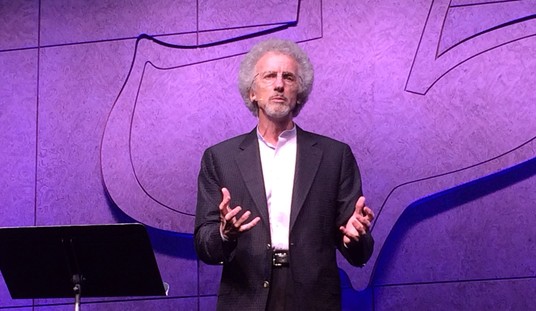
I’ve long enjoyed Jonathan Last’s articles at the Weekly Standard, whether it’s an iconoclastic look at who the real good guys were Star Wars, or a prophetic look at the similarities between England’s anti-war left in the 1930s, and America’s own self-described intellectuals today. For What to Expect When No One’s Expecting: America’s Coming Demographic Disaster, his first book, he decided to take on the topic of America’s coming demographic collapse, which could see the US facing the same birth-dearth that is crippling Japan and magnify our hemorrhaging entitlement problems until we’re the super-sized equivalent of Greece.
But in era in which the San Francisco Chronicle can quote the “founder of Washington state’s Progressive Kid, which has a Web site with suggestions on how to raise kids with good values,” when she says with a straight face that “There is nothing more bacchanalian than a kid’s birthday party,” (Really? Nothing more bacchanalian…in San Francisco…?), as Jonathan acknowledges in our interview, “I think that’s just sort of important to acknowledge, that people aren’t crazy. They’re not entirely irrational if they, you know, back away from having kids.” Along with a fair amount of tough love from Jonathan towards those who choose to become parents.
During our interview, we’ll explore:
● How Jonathan initially became interested in demographics.
● What he thinks about Mark Steyn’s America Alone, which famously argued, “It’s the demography, stupid!”
● What are the demographics of the Muslim world?
● What do professional demographers think about Paul Ehrlich, the author of the infamous 1968 book, The Population Bomb, which causes so many on the left to be terrified of overpopulation to this day?
● What caused previous American demographic slumps?
● How will America’s demographic decline exacerbate its ongoing fiscal hemorrhaging and education bubbles?
And much more. Click here to listen:
[audio:http://pjmedia.com/eddriscoll/files/2013/02/20130215-pjm-ED.mp3](17:30 long; 16MB file size. Want to download instead of streaming? Right click here to download this segment to your hard drive. Or right click here to download the 3MB lo-fi edition. And for our earlier podcasts, start here and keep scrolling.)
If the above Flash audio player is not be compatible with your browser, click below on the YouTube player below, or click here to be taken directly to YouTube, for an audio-only YouTube clip. Between one of those versions, you should find a format that plays on your system.
Transcript of our interview begins on the following page.
MR. DRISCOLL: This is Ed Driscoll for PJ Media.com, and we’re talking with Jonathan Last of the Weekly Standard, and the author of the new book, What to Expect When No One’s Expecting: America’s Coming Demographic Disaster. It’s published by Encounter Books, and available from Amazon and your local bookseller. And Jonathan, thanks for stopping by today.
MR. LAST: It is a pleasure.
MR. DRISCOLL: Jonathan, what initially made you decide to write a book on demographics?
MR. LAST: You know it’s a funny but ultimately kind of boring story. About six or seven years ago, I was reading a bunch of books, and I read three in a row that all mentioned demographics. And I’m a big endnotes nerd. I like looking at endnotes. And as I was going through them, they all referred to the same book. It was this book called The Empty Cradle, by a guy named Phil Longman.
And I went and I read Longman’s book. And it was just gobsmackingly awesome. Phil is a total liberal progressive democrat. He works for the New America Foundation in Washington. He is intellectually fearless and unbelievably honest and smart.
And anyway, I called Phil up and I said, you know, I’m not a stalker, but I work at the Weekly Standard a few blocks away; could I buy you lunch? And he said sure. And when we met, he was the biggest sweetheart in the world. I told him I was interested in this stuff. He sort of pointed me in different directions for reading and research, and I just started tumbling down the rabbit hole. So it’s all Phil’s fault. That’s — I blame him for it.
MR. DRISCOLL: Well, beyond Phil Longman’s efforts, how did you research the book? If you’re writing a book on demographics, where do you go for statistics on these sorts of numbers?
MR. LAST: Well, you know, it turns out there’s an enormous amount — enormous amount of research that’s done on this stuff, and by some really wonderful people. There was — really the nicest thing that happened to me in the course of spending the last three years writing this book is that I got to know a whole bunch of really smart academics: people at the Census Bureau; people at the U.N. Population Division; people in different think tanks in different universities, you know, both here and over in Europe. And they’re great people and they’re doing really interesting research.
And the problem with it is, it’s very math heavy, and the stuff they publish is, I would say, to a lot of people, kind of unreadable. And to me, I have a little bit of a math background. I was a science major as an undergraduate. I got as high as differential equations before I had to tap out and say I can’t take anymore.
And so I can read this stuff, and I enjoy reading it. And my book is — it really just stands on the shoulders of all the research that’s been done. And one of the things I found was really interesting as I researched all this, is that most professional and academic demographers are liberal. There are a few conservatives out there, but they’re mostly quite liberal.
And they — but there’s total agreement between the left and the right among the people who actually study this stuff and do the research. They all think the same thing. They all believe that we’re headed in this very bad direction. They all think that this is like the story of the last, you know, forty years. And it’s funny that only like among the lay left, you know, like the people who write for the New York Times, let’s say, or who blog for Slate, that’s where the disagreement exists. It’s not among, like, the professional left, you know, the professional liberals who actually follow the subject.
You know, I would say there’s remarkably little actual controversy in the world demographics. And what there is, is instead, a lot of people doing really interesting research, nibbling at the corners and trying to untie, you know, little pieces of the puzzle here and there.
MR. DRISCOLL: Jonathan, I watched your CBS Morning News segment, and I must say, they treated you surprisingly fairly, given that…it’s CBS. But the anchorwoman asked the question that you must be getting all the time from left-liberal interviewers: Why should I care about book when, for forty years, I’ve been hit over the head by the media that overpopulation was almost as big a concern as global warming?
MR. LAST: Yeah, you know, and I say this to people, I say, you know, it’s one of these weird situations where everything we think we know is wrong, and it’s all wrong because of one guy, Paul Ehrlich. Paul Ehrlich is not a professional demographer. He only plays one on TV. And he wrote what I think of as the most spectacularly wrong book ever written.
He was wrong in the particulars. He said that within a couple years, hundreds of millions of people were going to starve to death, and that nothing could be done to stop this. He said the population growth was going to increase asymptotically to the moon. That — neither of these things happened.
But more to the point, he was wrong at the moment when the exact opposite thing was happening. He published his book in 1968. In 1968, the fertility rates across the Western countries fell off of the table and went into steep, prolonged, sustained decline; decline which they are still experiencing today. So he was exactly wrong.
And what’s funny — and also, you know, slightly frustrating — but funny, is that again, in the world of professional demographers, like the people who do this for a living, the people who are tenured professors and who work at the United Nations, they all — you know, for the last thirty-five, forty years, have basically ignored Ehrlich and viewed him as sort of a crank. And they’ve been actually focusing the bulk of their research on exactly the opposite question. Where has the global fertility decline come from?
And that’s the big question that I tackle. And I sort of focus on America, because I — you know, we live here. I’m interested in it. But I would say, you know, again, and these people who are liberal, they would vote for, you know, whatever the liberal party is in their country; they all love Barack Obama. But they all view Paul Ehrlich as a crank too. It’s just that his books, I think, really touched a spot with the sort of deeply anti-humanist strain of the environmental movement.
I mean, you scratch a lot of environmentalists like deep enough, and eventually you’ll get them to say, like, people are cancer; that we must protect Mother Gaya. And you know, at the end of the day, everybody’s got to believe something. You know, they don’t believe in god, so they believe in that stuff. And I say more power to ’em. But you know, it’s not really based on data or research or science, it’s just theology.
MR. DRISCOLL: Now, our current period of demographic decline isn’t the first time that America has had a birth dearth. What has caused them in the past?
MR. LAST: Well, you know, we’ve been heading downward ever since the founding. The total fertility rate — that’s the number of children born to the average woman — was about seven around the time of the 1800 census. And it was gradually declining from there clear on through the Great Depression. The Great Depression helped push it down a little bit. And we’ve only had one major moment of increase, and that was the baby boom. And for about twenty years, we had significantly elevated fertility. And then by 1968 it slumped back down and fell off the table.
Now, it’s funny. In America we think that we’re okay because our fertility rate is about 1.9 right now. And 1.9 is not bad at all. If we could sustain 1.9, then I wouldn’t have written the book and I would have thought that everything was fine. But I think that’s really misleading. And it’s misleading because that 1.9 is really a mathematic construct created by the immigration we’ve received over the last thirty years.
We’ve had thirty-eight million immigrants in the last thirty years. That’s the biggest sustained wave of immigration in our country’s history. And when you strip those numbers out, you strip out the actual warm bodies and you strip out the elevated fertility rate that they bring with them, America looks like Europe. We look exactly like Europe in terms of our demographics. And that’s a much sterner, scarier proposition.
Now, again, I say if you strip them out we look like Europe. And this worries me because a lot of demographers believe that we may not continue to receive this wave of immigration. Whatever we think about it here, whether you think we should have a fence or Amnesty or DREAM Act or whatever, those are all demand side. There’s a supply side issue to it as well. And the supply side is, countries with sub-replacement fertility historically do not send immigrants out into the world.
And all the fertility rates in Central and South America are headed south on an express elevator. Many of those countries are already below the replacement rate, and none of the countries in Central and South America below the replacement rate send us any significant amount of immigrants.
MR. DRISCOLL: Today though, in addition to our flat-lined economy, there are societal pressures to not have kids. Can you talk a bit about those?
MR. LAST: Yeah. You know, and this is one of those interesting things that I found. We hear a lot about this, right, about non-traditional families and how people’s mores are changing and the patriarchal structures no longer hold sway over us. You’ve heard this before, I’m sure.
But the data shows some very interesting things. You know, so marriage is generally on the decline in America. But ninety percent of Americans get married at some point. That’s a lot. I mean, it’s low, historically, for our nation, but it’s still nine of out ten. Now, whether or not these marriages last, I don’t think a lot of people get married hoping they’re going to get divorced. You know, it suggests that they would like to be married.
And then you look at what’s called ideal fertility. Demographers measure this. They talk — you know, you ask people at various points in their life what they think the ideal number of children to have is. And this is a remarkably interesting finding and it surprised the heck out of me. The first thing that’s surprising about it is that men and women have very similar ideal numbers. I would not have expected that. I suspected one sex would be higher or lower than the other. They’re not.
The other thing is that people’s idea of the ideal changes over time. When you’re twenty you have a lower ideal number than you do when you’re thirty-five. And so people shift that number a little bit older — a little bit higher as they get older.
But the final thing that was surprising is that our ideal is 2.5, and it has been 2.5 for forty years. It’s been remarkably stable. People still want families. The real thing that’s happening is, you know, with our fertility rate of 1.9, we’re just not achieving them.
And I think that’s actually sort of hopeful, because it suggests that, you know, there’s this divide here between what people would like to do and what they feel they can do and, you know, and what they eventually achieve. And if you can find a way to bridge that divide and sort of help people achieve the families they want, then, like, you know, there’s room to be hopeful.
My book does not — does not in any way argue for people who don’t want children to have children. I have three kids. I am totally unromantic and unsentimental about it. And I really — I say to people who don’t want kids, god bless you. Raise a glass and pour one for me tonight.
But on the other hand, those people, you know, not to deny the validity of their experiences, but they are not the median experience in America. People still do want kids.
MR. DRISCOLL: Yeah, and one of the things that’s fascinating about your book is that it’s got some surprisingly tough love for those parents who choose to have kids.
MR. LAST: Yeah, well, you know. I well — I’m sort of an unsentimental guy, period. But yeah, I mean, there’s no papering over it. And you know, as a parent, I would say, when I’m in line at the grocery store and somebody comes up to me as my three kids are crying and says, oh, treasure these moments, they go by so fast; I think to myself, really? This is sterling. So nothing, nothing bothers me more than sentimentality about parenthood and children.
And look, there are lots of parents who really do love — really, really do love parenthood and who have a wonderful experience with their children. And I — that’s great. I applaud them. But again, my book, is — it’s very data-driven. I always go to the data.
And there’s a lot of research on what we’ll call by shorthand, parental happiness. And it suggests that if you have two people who are similar in every demographic marker: the same religion, the same race, same income, they live in the same place, the only difference between them is that one of them is a parent is not a parent, the nonparent is going to be about six percentage points happier than the parent. You lose about six percentage points of happiness when you have a kid. And then you lose another two points for each additional kid.
So I guess the good news is, there’s an economy of scale. But the bad news is that you’re still less happy when you have kids. And you know, I think that’s just sort of important to acknowledge, that people aren’t crazy. They’re not entirely irrational if they, you know, back away from having kids.
MR. DRISCOLL: In America Alone, Mark Steyn warned that the Muslim world was going to win the demographic war against the West. But as you write in What to Expect When No One’s Expecting, several Middle Eastern nations are having demographic crises of their own.
MR. LAST: You know, Mark’s book is great. God, I loved that book when I read it. And I still love it today. And he’s not wrong. I mean, so Mark’s point was that it’s a game of last-man-standing. And there’s a lot of truth to that. And he’s right in this respect, that the Muslim countries tend to be tailing everybody else in their fertility decline, but they’re declining too.
I think there’s sort of — you know, the common perception that well, you know, over in Iran, they’re just breeding like crazy, and they’re not. Actually Iran has a lower fertility rate than we do, right now. And when you look at the slopes of those curves, you look at the dx/dt, many of the Muslim countries, although they began their fertility decrease at much later dates, their rate of fertility decreases are much faster than we’re experiencing in the West.
Now there are some places which are exceptions. Nigeria, the Muslim population in Nigeria has shown no decrease in overall fertility. And in the West Bank, actually, in the Palestinian territories, their fertility rates have remained incredibly high without showing any signs of decreasing.
But in general, I mean, the Muslim world is going to suffer from the same consequences we are. The big difference, though, is that many of those countries are not rich. And it is one thing to get old and decline in terms of your population when you are a wealthy First World country. It is quite another to do so when you are not.
MR. DRISCOLL: Jonathan, getting back to demographics in the United States, Glenn Reynolds of Instapundit.com has two books out from, I believe, the same publisher as What to Expect When No One’s Expecting, which explore the Higher Education Bubble and the K through 12 Implosion. How does the skyrocketing cost of education impact American demographics, or perhaps, vice-versa?
MR. LAST: Well, you know, it impacts it in three ways. You know, there’s a front end and a back end, and then there’s a straight-up timeline way — chronology end. So on the back end, people who graduate from college graduate with a lot of debt. They say in surveys that that debt — you ask them and they tell you — that debt is making them hold off on getting married and making them hold off on having children.
Going forward, prospectively, you know, if you — if you were today to have a kid and think about what it would be like to put that kid in college today, that is the equivalent of buying basically a house and a half. The average cost of a house in America is 185,000 dollars. The average cost of college tuition right now is something like 212,000, or something like that.
The real cost of college since 1965, the real cost — this is accounting for inflation, has increased by 1,000 percent. You know, if this was any other sector — and Glenn makes this point — any other sector, we would be saying this is broken; this needs to be reformed. But because it’s education, we just keep pushing people into it.
So those are the front end and the back end effect. But the other effect, the chronological one, is that it just keeps pushing back the average time of family formation. So you don’t graduate until you’re twenty-two or, you know, maybe twenty-three or twenty-four. And that’s just with undergraduate. So now you don’t even begin to think about family formation and you don’t get married until, say, twenty-seven, which is, I think, about what our average age of first marriage is now. A dramatic rise since the early 1970s.
You then look at time of first birth. Most people try at least to not have that first birth until after they’re married. And that gets pushed back until you’re now your late twenty-eight, early twenty-nines. And then you run up into the wall of biology. You know, after thirty-five, it becomes harder for women to get pregnant, after thirty-nine, it becomes really, really hard for women to get pregnant.
And so you can see why, you know, somebody who wants to have, you know, two or three kids, if they’re not getting started till they’re twenty-nine or thirty, all of a sudden, that becomes, just as a logistical matter, kind of tough.
MR. DRISCOLL: Jonathan, last question, because I know you’re on the whirlwind tour today to promote the book. Do you think that Obama, or anybody in DC, for that matter, is taking the issue of America’s demographic decline seriously?
MR. LAST: Well, Obama sure isn’t. You know, in a funny way, actually Rick Santorum, he didn’t talk about this explicitly during the campaign, but he alluded to it a lot. And he sort of tied it into, sort of, you know, talking morally about capitalism and the free market and the middle class in a very populist way. I actually thought that was kind of interesting and effective. He was the only one selling that sort of thing in the Republican field.
Now, of course, I would say this because I’m a crazy person and I’m obsessed with demographics. But I actually do think that there is a really elegant and interesting way for Republicans to create a populist case for supporting middle class families centered around the idea of not hectoring people into having babies, but trying to take the policy changes that will help people have the families that they want to have.
And I think there’s a way for Republicans to do it. I think Rick Santorum was sort of edging in that direction. And I’ll be surprised if somebody in the 2016 field doesn’t decide to take a flyer with this.
MR. DRISCOLL: This is Ed Driscoll for PJ Media.com, and we’ve been talking with Jonathan Last of the Weekly Standard, the author of the new book What to Expect When No One’s Expecting: America’s Coming Demographic Disaster. It’s published by Encounter Books, available from Amazon.com and your local bookseller.
And Jonathan, thank you once again for stopping by today.
MR. LAST: It’s great to be with you. Thanks, Ed.
(End of recording.)










Join the conversation as a VIP Member